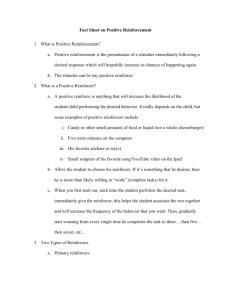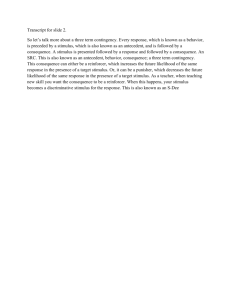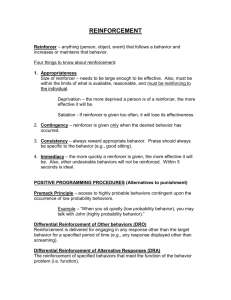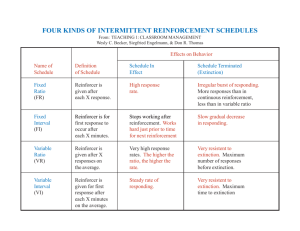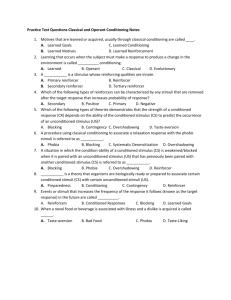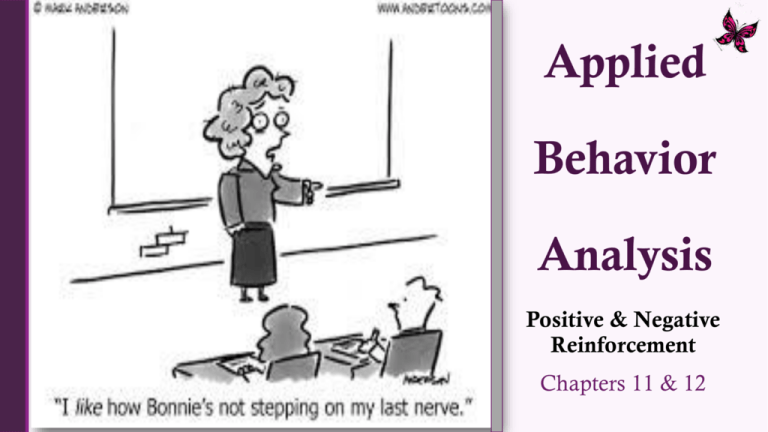
Applied
Behavior
Analysis
Positive & Negative
Reinforcement
Chapters 11 & 12
Questions from:
Last class or Chapter 2?
In-class quiz (20 minutes)
►Review quiz
►Review HW 1
►Lecture
►
ESSPED 5742
3
Objectives
Define and provide examples of:
Positive
& negative reinforcement
Motivating operations (MO), stimulus control, and
discriminative stimuli (SDs)
Define & provide examples of:
Unconditioned
and conditioned reinforcers (UR, CR)
Describe methods to identify potential reinforcers
Describe how to use reinforcement correctly
Objectives
Describe the differences between SDs and MOs
Given a scenario, identify
Motivating operations (MOs)
Discriminative stimulus (SD)
Whether it is an example of positive or negative
reinforcement
The potential function of behavior
Review: Respondent Conditioning
Antecedent
A
Stimulus
Behavior
B
Response
Before conditioning:
• Unconditioned stimulus elicits the
unconditioned response (e.g., meat powder
elicits salivation)
• Neutral stimulus elicits nothing
Review:
Respondent
Conditioning
During conditioning:
• Unconditioned stimulus elicits the unconditioned response
• Neutral stimulus paired with unconditioned stimulus elicits
salivation (e.g., bell paired with food elicits salivation)
After conditioning:
• Unconditioned stimulus elicits unconditioned response
• Conditioned stimulus (previously the neutral stimulus)
elicits a conditioned response (i.e., salivation)
Review: Operant Conditioning
Antecedent
A
Stimulus
• Evoked by
antecedent stimuli
Behavior
Consequence
B
C
Response
Consequence
• Maintained by consequence
•Pos. +R = add stimulus & bx.
•Neg. +R = remove aversive
stimulus & bx.
•Pos. +P = add stimulus & bx.
•Neg. +P = remove stimulus & bx.
Respondent
Behavior is elicited by antecedent
stimuli
• Antecedent stimulus (US or CS) causes
the response (UR or CR)
Behavior is involuntary (i.e., reflexive)
Eye blink
Salivating
Heart beating fast
Typically involves action from autonomic
nervous system
• Association between involuntary
response and stimulus
•
•
•
•
A & B (2 term contingency)
• S-->R
Operant
Behavior is evoked by antecedent
stimuli
• Antecedent stimulus changes probability
of whether response will occur again
Behavior is voluntary
•
•
•
•
Throwing a ball
Singing
Eating
Association between voluntary response
and consequence
A, B, & C (3 or 4 term contingency)
• R-->S
Behavior is maintained by its
consequence
Review: Keep in mind the following…
We reinforce or punish the person’s behavior
Correct: Alex is crying because in the past, his behavior has been reinforced
Incorrect: Alex is crying because in the past he has been reinforced
Respondent bx. is elicited & operant bx. is evoked
Positive
pleasant or good; Negative
bad
Positive = added to the environment
Negative = removed from the environment
Individual differences (i.e., items that function as reinforcers are idiosyncratic)
No two people experience the world the same; different learning histories (i.e., history
of reinforcement)
Be aware of circular reasoning!
Circular reasoning:
To
attribute cause of a behavior to a process or a thing
(behavior is a symptom of some underlying condition)
Circular reasoning
DON’T Attribute cause of a
behavior to a process or a
thing (i.e., behavior is a
symptom of some underlying
condition)
Why does
Johnny
leave his
seat
frequently?
Because
he leaves
his seat
frequently
He has
ADHD
(condition)
(symptom)
How do
you know
he has
ADHD?
Circular reasoning
•
Why does
Johnny
leave his
seat
frequently?
Thus, we are using cause to
explain cause
Because
he leaves
his seat
frequently
He has
ADHD
(condition)
(symptom)
• Circular reasoning adds nothing
to S-R or R-S relationship
How do
you know
he has
ADHD?
Why does
Matt hit his
head on the
wall?
Circular reasoning
Because
he hits his
head on
the wall
He has
Autism
(condition)
(symptom)
How do
you know
he has
Autism?
Circular reasoning for Respondent Conditioning
Don’t say that conditioned salivation or emotional
responses occur because:
The
child expects to hear the loud noise when he sees the
bunny
The dog now knows of the tone-food relationship
The child now knows of the bunny-loud noise relationship
The dog now associates the tone with food
The child now associates the bunny with the loud noise
How can we discuss Respondent Conditioning?
Describe the functional relationship between the IV &
DV
The child shows an emotional response (i.e., increased
heart rate & breathing) when he sees a bunny because:
When
the bunny was paired with the loud noise, it acquired
the eliciting properties of the loud noise
The bunny functions as a conditioned stimulus (CS) & elicits
an emotional response because it was paired in the past with
the unconditioned stimulus (US)
Brief review
Negative reinforcement
Function of behavior
Negative reinforcement review
Negative reinforcement:
https://www.youtube.com/watch?v=Vb8xXp4y-nQ
ASR: Neg. reinforcement
Negative reinforcement example
Daniel is on his way to school and sees a group of bullies en route. In the
past, this group of bullies has taken his lunch money and tossed his book
bag. As such, Daniel decides to take a different, yet longer, route to school.
On subsequent days, Daniel continues to take the longer route to class.
What is the
antecedent?
What is the
behavior?
What is the
consequence?
ASR: Neg. reinforcement
Negative reinforcement example
Daniel is on his way to school and sees a group of bullies en route. In the
past, this group of bullies has taken his lunch money and tossed his book
bag. As such, Daniel decides to take a different, yet longer, route to school.
On subsequent days, Daniel continues to take the longer route to class.
A = Bullies present
B = Taking a different route
C= Bullies no longer present
Daniel effectively avoided
the bullies by taking a
different route
The aversive stimulus (i.e., the bullies) were
removed from Daniel’s presence when he
decided to take a different path to class
WTF??!!
What's’ the function?
Function
2 main functions:
To access
something
desirable
Function
2 main functions:
To avoid
something
undesirable
WTF??!!
What's’ the function?
http://www.youtube.com/embed/OxdtMVww2q0
ASR:
What do you think may be the function of the child's
behavior?
Is the child’s behavior being:
Positively reinforced
Negatively reinforced
Positively punished?
Negatively punished?
Is the mother’s behavior being:
Positively reinforced
Negatively reinforced
Positively punished?
Negatively punished?
ASR:
What do you think may be the function of the child's
behavior?
Access
to tangibles
Is the child’s behavior being:
Positively reinforced
Negatively reinforced
Positively punished?
Negatively punished?
Is the mother’s behavior being:
Positively reinforced
Negatively reinforced
Positively punished?
Negatively punished?
1
New material
Discriminative stimulus
D
(S
) & S-delta
∆
(S )
Discriminative Stimulus (SD ):
A
stimulus in the presence of which a response has been
reinforced
And in the absence of which a response has not been
reinforced
S-delta (S∆ ):
A stimulus in the presence of which a response has not been
reinforced
SDs have to do with the availability of the reinforcer
Let’s put this in context…
Response:
Hail a Taxi
Get taxi
Do not get taxi
Let’s put this in context…
Response:
Hail a Taxi
Get taxi
Do not get taxi
• Responses are reinforced in the presence of one stimulus
• Responses are not reinforced in the presence of other stimuli
Why does this occur?...
Response:
Hail a Taxi
Get taxi
Do not get taxi
•
Why does this occur?
Because in the past hailing a taxi was reinforced only when the taxi was
unoccupied (reinforcer was available)
So…
• The next time we need a taxi, we will only engage in hailing when we see an
unoccupied cab
• The unoccupied taxi becomes a Discriminative Stimulus (SD) for hailing taxi
• The occupied taxi becomes S-delta (S∆) (reinforcer is not available)
Remember…
In order for a stimulus to be called an SD :
There
must be history of differential reinforcement:
The behavior was reinforced in the presence of the stimulus
• And not reinforced in its absence
•
Effects on behavior:
(SD)
•
for reinforcement
Has an evocative effect on the response
S-delta
•
(SΔ) for reinforcement
Has an abative effect on the response
Question
In the previous example, an individual was standing in
the rain and hailed a taxi. A week later, as soon as it
looked like it was going to rain, she immediately
looked for a free taxi.
Is this an example of:
a)
b)
c)
d)
e)
Positive reinforcement
Negative reinforcement
Positive Punishment
Negative Punishment
Not enough info
A
B
C
D
E
Example SD
Teacher gives
child toy
SD:
Child wants
access to a
specific toy
Teacher Marie
Behavior:
Scream
SΔ :
Teacher Jen
Teacher does NOT
give child toy
Marie reinforced
crying by giving
access to the toy
Example SD
SD:
Teacher Marie
In the future, the child is more likely to cry to get access
to the toy in the presence of Marie and not in the
Behavior:
presence
of
Jen
Scream
Child wants
access to a
specific toy
SΔ :
Teacher Jen
Jen did not reinforce the behavior;
therefore, the child is less likely to
cry for access in her presence
Another example
SD:
Reinforcer:
Teacher Marie
Break from work
Response:
Scream
SΔ:
Teacher Melissa
No break from work
In the future, the child is more likely to cry to get out of
working in the presence of Marie and not in the presence
of Jen
D
S
(Summary)
Answers the question: How do we learn to emit certain
behaviors at specific times but not at other times?
SD = a stimulus change that occurs before the behavior
Stimulus change evokes behavior or sets the occasion for
behavior to occur
SDs have to do with the availability of a reinforcer (i.e., has the
reinforcer been delivered in the presence of that stimulus in the
past?)
Responses that occur in the presence of the SD are reinforced
Responses that occur in the presence of the S-delta are not
reinforced or receive a lesser quality reinforcer
Stimulus Control
A response occurs more frequently in the presence of
one stimulus than in the presence of another
Behavior: Screaming
Scream in the presence of
Teacher Marie
and not in the presence of
Teacher Melissa
Therefore, screaming is under the stimulus control
of teacher Marie
Stimulus control
Stimulus control:
The tendency
for should
the targetbe
behavior
occur
in the presence
Stopping
your car
undertothe
stimulus
control of the
of the SD, but not in the presence of the SΔ
red light
•
E.g. If you are a good driver… then you will discriminate between red
lights and green lights!
Driving through an intersection should be under the stimulus
control of a green light
Remember…
In order for a stimulus to be called an SD :
There
must be history of differential reinforcement:
The behavior was reinforced in the presence of the stimulus
• And not reinforced in its absence
•
Effects on behavior:
(SD)
•
for reinforcement
Has evocative effect on the response
S-delta
•
(SΔ) for reinforcement
Has abative effect on the response
Example: Development of stimulus control
What is 4 x 2?
8
Yes! It is 8
Example: Development of stimulus control
What is 4 x 2?
10
No. That is
incorrect
Stimulus control
When a child’s behavior comes under the control of the
SD :
We
say the SD has acquired stimulus control over the child’s
behavior
Stimulus control
When a child’s behavior comes under the control of the
SD :
We
say the SD has acquired stimulus control over the child’s
behavior
Example:
The
vocal verbal stimulus (what is 4 x 2) gains stimulus control
over the response “8”
Circular reasoning for Operant Conditioning
Don’t say that the antecedent stimulus (SD):
Informs
the organism of the availability of a reinforcer
Don’t say the child:
the antecedent stimulus (SD) with the reinfrocer
Expects to get a reinfrocer when he sees the SD
Knows that the reinfrocer is available
Thinks that he or she will get reinforced
Figured out that when the SD is present he or she can get
reinforced
Associates
How can we discuss Operant Conditioning?
The presence of teacher Marie sets the occasion for the
response to be reinforced
The teacher provides an opportunity for the behavior to
access the reinforcer
The teacher evokes a response that has been reinforced
in the past
The child learned to cry in the presence of teacher
Marie because in the past crying was reinforced by that
teacher
ASR
The following sentence is correct, True or False: The
child engages in that behavior because he knows his
behavior will be reinforced
or
ASR
The following is an example of circular reasoning, True
or False: The child engages in that behavior because in
the past his behavior has been reinforced in the presence
of mom
or
ASR
True or False: SDs have to do with the availability of
the reinforcer?
or
Questions?
Motivating operations (MO)
https://www.youtube.com/watch?v=r79tq-gCxKk
Child is
deprived of
attention
Behavior:
SD:Mom
Scream
Example MO
Mom gives child
attention
Motivating operations
The thing that is “wanted” will function as a
reinforcer at that moment in time
AND
At that moment, behavior that has been
previously reinforced with that thing are more
likely to occur
Motivating operations
MOs have two parts:
1. Increase the reinforcing or punishing value of an object,
stimulus, or event (value altering effect)
Has to do with the effectiveness of a reinforcer or punisher
(e.g., Is the “reinforcer” reinforcing at that moment in
time?)
2. Evoke or abate behaviors that have been reinforced or have
accessed object, stimulus, or event in the past
Evokes or abates the current frequency of behavior not
future frequency
2 Types of MOs
Establishing Operations:
Increases the reinforcing effectiveness
of a consequence
Increases the current frequency of the
behavior to access that consequence
MO
• Establishing
Operation
(EO)
Effect
• ↑ Reinforcing
effectiveness
• ↑ Behavior
(Evokes behavior)
2 Types of MOs
Establishing Operations:
Increases the reinforcing effectiveness
of a consequence
Increases the current frequency of the
behavior to access that consequence
MO
Effect
• Establishing
Operation
(EO)
• ↑ Reinforcing
effectiveness
• ↑ Behavior
(Evokes behavior)
• Abolishing
Operation
(AO)
• ↓ Reinforcing
effectiveness
• ↓ Behavior
(Abates behavior)
Abolishing Operations:
Decreases the reinforcing
effectiveness of a consequence
Decreases the current frequency of
the behavior to access that
consequence
What variables determine if we want something or not?
Deprivation: Lacking the reinforcer
Any behavior that accessed the reinforcer in
the past will be emitted at the first opportunity
Satiation: Consuming or accessing a
substantial amount of a reinforcer
Temporarily reduces responding even when
the reinforcer is freely available
Example MO
Child wants
access to a
specific toy
SD:
Teacher Marie
Behavior:
Ask for toy
Teacher gives
child toy
Example MO
The child wants a toy (MO):
This makes the toy a more effective reinforcer
AND
Evokes behaviors that have lead to accessing that toy in the
past
Example MO
Child wants
access to a
specific toy
SD:
Teacher Melissa
Behavior:
Cry
Teacher gives
child toy
MO vs. SD
• How
are they similar?
They both precede behavior
They both evoke operant behavior (but for very different reasons)
• How
do they differ?
SDs have to do with the availability of a reinforcer (Has the reinforcer been delivered
in the presence of that object in the past?)
MOs have to do with the effectiveness of a reinforcer (Is the “reinforcer” reinforcing
at that moment in time?)
Changes the value of the consequence (e.g., the reinforcer)
MO vs. SD
In short:
MOs change how much people want something
SDs change their chances of getting it (Carbon et al., 2007
pg. 665)
Ask yourself:
• Is this antecedent event making the reinforcer more
available?
OR
Is it making the reinforcer more valuable
MOs and SDs
MO:
Good sleep the
night before &
breakfast
SD:
“Who can
count to 10
for me?”
Response:
Correct
Answer
Yes! Well
done!
66
MOs and SDs
MO:
Good sleep the
night before &
breakfast
MO:
No sleep, no
money for
breakfast
SD:
“Who can
count to 10
for me?”
Response:
Correct
Answer
SD:
“Who can
count to 10
for me?”
Response:
Incorrect
Answer
Yes! Well
done!
Let’s try
someone else.
67
Motivating Operations (MO) For Positive +R
You have been working all day and did not have a chance to
eat. On the way home, you see a sign for the TGIF
restaurant. In the past, going into TGIF has always been
reinforced with getting food. You pull into the parking lot
and walk into the restaurant. In regards to pulling into the
parking lot
Food
deprivation is: An EO
The sign for TGIF is: An SD
Contingency diagram for the prior scenario
Immediate
Antecedent
Food
deprivation
(EO)
TGIF
sign
(SD)
Walk into the
restaurant
(Behavior)
Sit down to
order food
(Consequence)
Motivating Operations (MO) For Positive +R
You had a large meal at TGIF. On the way home, you see
a sign for the Cheesecake Factory, which is your favorite
place to eat. In the past, going into Cheesecake Factory
has always been reinforced with getting food. You look at
the sign and continue driving home. In regards to eating
at Cheesecake Factory
Large
meal at TGIF is: An AO
The sign for Cheesecake Factory is: An SD
Contingency diagram for the prior scenario
Antecedent
Eating food (being satiated) abolishes food as a
Cheesecake reinforcer!
Drive past
Driving without
Satiation
AO
sign
(SD)
restaurant
(Behavior)
getting food
(Consequence)
Food is available, but is only reinforcing when he/she is food deprived
MOs and SDs
Is the sign for the Cheesecake Factory making the
reinforcer more available or more valuable?
More available:
• Just because you see a sign for the restaurant, it
does not mean that you will stop to eat at the
restaurant
• If you are full after a large meal (satiated), you
are less likely to go to the restaurant
• Thus, the reinforcer is not more valuable in the
presence of the restaurant it is just more available
MOs and SDs
Does lack of food make the reinforcer more available or
more valuable?
More Valuable:
• You are deprived of food; therefore, food is a more
effective reinforcer
• Just because you are deprived of food, however,
does not mean that food is more available
• Thus the reinforcer is not more available when you
are deprived of food but it is more valuable & will
evoke behaviors that lead to food in the past
Availability vs Motivation For Reinforcement
Elopement maintained by attention
Elopes when with dad but not when with mom
Available
SD
Dad
Not Available
SΔ
Mom
Valuable
EO
Likelihood
Of Elopement?
High
Likelihood
Of Elopement?
Low
Not Valuable
AO
Likelihood
Of Elopement?
Very low
Likelihood
Of Elopement?
Almost 0
Deprived of Attention
Had a lot of Attention
Availability vs Motivation For Reinforcement
Elopement maintained by attention
Elopes when with dad but not when with mom
A
B
Dad
Elopement
Mom
Elopement
C
Attention
Deprived
of
Attention
NO Attention
Motivating Operations
Unconditioned MO (UMO)
Unlearned stimulus condition with value altering
effect (alters the value of the consequence)
Unconditioned EO (UEO)
o Food deprivation
o Water deprivation
o Sleep deprivation
o Activity deprivation
o Oxygen deprivation
o Sex deprivation
o Being too warm
o Being too cold
o Increase in painful stimulation or discomfort
o Effects of some drugs
• Unconditioned AO (UAO)
o Opposite of UEOs (ingestion or engaging in a
specific activity)
Conditioned MO (CMO)
Learned stimulus condition with value
and behavior altering effect
Surrogate CMO (CMO-S)
Reflexive CMO (CMO-R)
Transitive CMO (CMO-T)
ASR
Provide one example of a motivating operation (list the
four term contingency):
Motivating
operation
Discriminative stimulus
Behavior
Consequence
ASR
True or False: Food deprivation is an AO?
or
ASR
True or False: Being too hot is an EO?
or
ASR
An SD means that the consequence is more:
a)
b)
c)
d)
Reinforcing
Punishing
Available
Potent
Positive Reinforcement
Types of reinforcers
Unconditioned reinforcers (Primary reinforcer)
Unlearned
stimuli that increase the probability of a response
Biological importance
• Do not require learning
• Examples: air, food, water, sleep, warmth, etc.
•
Types of reinforcers
Conditioned reinforcers (Secondary reinforcers )
Neutral stimuli with no biological importance
Repeatedly paired with Unconditioned reinforcer (UR) or conditioned
reinforcer (CR)
acquires capacity to increase responses
• Examples: Praise, smile, toys, etc.
•
Types of reinforcers
Generalized conditioned reinforcers
Neutral
stimuli with no biological importance
Repeatedly paired with Unconditioned reinforcer (UR) or conditioned
reinforcer (CR)
acquires capacity to increase responses
• Less likely subjected to the same effects of satiation & deprivation (EO does
not need to be in effect for the stimulus to function as a reinforcer)
• Examples: Money, attention, tokens, points, etc.
•
Types of reinforcers
Edible
Tangible
Activity
Social
Edible = food
Tangible = toys, stickers, TV
Activities = playing a board game,
leisure reading, listening to music
Social = hugs, pat on back, praise
Factors that affect reinforcers
Motivating operations:
Temporarily
alter the effectiveness of a reinforcer & alter
the current frequency of behavior that lead to obtaining
the reinforcer in the past
Deprivation vs. Satiation
• Most
reinforcers will not be effective unless the individual has
been deprived of them for some period of time prior to their
use (establishing operations vs. abolishing operations)
o
Above, however, does not pertain to generalized
conditioned reinforcers
Factors that affect reinforcers
Reinforcer Size:
The
size (or amount or magnitude) of a reinforcer is an
important determinant of its effectiveness
Sufficient to strengthen the response, but not enough to
satiate
Factors that affect reinforcers
Reinforcer presented contingently:
The
delivery of the reinforcer should depend on the occurrence
of a specific behavior you are targeting
Factors that affect reinforcers cont.
Reinforcer Immediacy:
For
maximum effectiveness, a reinforcer should be given
immediately after the desired response
•
The longer the delay between the behavior and the reinforcer, the less
impact the reinforcer will have on the behavior
Factors that affect reinforcers cont.
Reinforcer Immediacy:
For
maximum effectiveness, a reinforcer should be
given immediately after the desired response
• The
longer the delay between the behavior and the
reinforcer, the less impact the reinforcer will have on
the behavior
o Other behaviors may occur during the delay
o So, you will be strengthening the response of those
OTHER behaviors!
Factors that affect reinforcers cont.
Reinforcer Immediacy:
Remember:
The behavior temporally closest to the
For maximum effectiveness, a reinforcer should be given immediately after
presentation
of the reinforcer will be strengthened!
the desired response
•
The longer the delay between the behavior and the reinforcer, the less impact the
reinforcer will have on the behavior
o
o
Other behaviors may occur during the delay
So, you will be strengthening the response of those OTHER behaviors!
Methods of identifying potential reinforcers
Ask about preferences
Methods of identifying potential reinforcers
Ask about preferences
Methods of identifying potential reinforcers
Ask about preferences
Free operant observation
Methods of identifying potential reinforcers
Ask about preferences
Free operant observation
Many variations of trial-based methods
Effective Application of Positive Reinforcement
1. Select the behavior to be increased:
The
target behavior should be a specific behavior rather
than a general category
2. Select reinforcers that (if possible):
Are readily available
Can be presented immediately following the desired
behavior
Can be used over and over again without causing rapid
satiation
Effective Application of Positive Reinforcement
3. Initially set achievable criterion to contact reinforcement
4. Provide a sufficient magnitude & quality of the reinforcer
5. Vary reinforcers to prevent satiation
6. Ensure the student can explain the reinforcement
contingency
Effective Application of Positive Reinforcement
7. Reinforce every “correct’ response initially (continuous
schedule of reinforcement)
Eventually
weeks)
you will thin the schedule (we will cover this in a few
Effective Application of Positive Reinforcement
7. Reinforce every “correct’ response initially (continuous
schedule of reinforcement)
Eventually
weeks)
you will thin the schedule (we will cover this in a few
8. Gradually shift from contrived to naturally occurring
reinforcers (e.g, social reinforcers instead of food)
Reinforcement vs. bribery
Reinforcement
• Reinforcer
is delivered contingent
on the target behavior
E.g., (child sitting in classroom teacher
approaches) “If you finish ten problems
on this worksheet, you can access five
minutes of computer time.”
Bribery
• Something
the child “wants”
is delivered before the target
behavior
E.g., “If you promise to be good during our
trip to the grocery, I will give you a cookie
now”
Something the child “wants”
only comes available when
he/she starts to misbehave
E.g., (Child is fighting with sister and
mom comes over) “If you stop fighting
with your sister, we will go to your
favorite restaurant now
Reinforcement vs. bribery
Reinforcement
Bribery
• Something the child “wants” is
is delivered contingent
Main
a reinforcer:
delivered
before the target
on the difference:
target behaviorWhen delivering
• Reinforcer
behavior
sitting in classroom
teacherof time
• E.g.,
You(child
communicate
ahead
(i.e.,
BEFORE
the
E.g.,
“If
you
promise
to
be
good
during
our trip
approaches) “If you finish ten problems
to the grocery, I will give you a cookie now”
bad
behavior
occurs)
what
behaviors
will and will not
on this worksheet, you can access five
minutes of computer time.”
• Something the child “wants”
access a reinforcer
only comes available when
he/she starts to misbehave
E.g., (Child is fighting with sister and mom
comes over) “If you stop fighting with your
sister, we will go to your favorite restaurant now
ASR: Let’s practice
Danny sees his favorite toy (a fire truck) locked in the cabinet;
however, he cannot access the toy by himself. In the past, when
Danny asked the teacher to open the door to access the truck, the
teacher opened the door. However, when Danny asked a peer to
open the door, he/she never complied with the request.
Based on the scenario above, what is the MO?
a) The presence of the teacher
b) The presence of the peer
c) Seeing the cabinet
d) Seeing the toy truck behind the locked cabinet
ASR: Let’s practice
Danny sees his favorite toy (a fire truck) locked in the cabinet;
however, he cannot access the toy by himself. In the past, when
Danny asked the teacher to open the door to access the truck, the
teacher opened the door. However, when Danny asked a peer to
open the door, he/she never complied with the request.
Based on the scenario above, what is the SD?
a) The presence of
b) The presence of
c) The presence of
d) The presence of
the teacher
the peer
the cabinet
the toy
ASR: Let’s practice
Danny sees his favorite toy (a fire truck) locked in the cabinet;
however, he cannot access the toy by himself. In the past, when
Danny asked the teacher to open the door to access the truck, the
teacher opened the door. However, when Danny asked a peer to
open the door, he/she never complied with the request.
Based on the scenario above, what is the S-delta?
a) The presence of
b) The presence of
c) The presence of
d) The presence of
the teacher
the peer
the cabinet
the toy
ASR: Let’s practice
Danny sees his favorite toy (a fire truck) locked in the cabinet;
however, he cannot access the toy by himself. In the past, when
Danny asked the teacher to open the door to access the truck, the
teacher opened the door. However, when Danny asked a peer to
open the door, he/she never complied with the request.
Based on the scenario above, what is the behavior?
a) Asking to open the door
b) Asking to play with a toy
c) Opening the door
d) The presence of the cabinet
ASR: Let’s practice
Danny sees his favorite toy (a fire truck) locked in the cabinet;
however, he cannot access the toy by himself. In the past, when
Danny asked the teacher to open the door to access the truck, the
teacher opened the door. However, when Danny asked a peer to
open the door, he/she never complied with the request.
Based on the scenario above, what is the reinforcer?
a) The teacher
b) The peer
c) Access to the toy
d) A closed door
ASR: Let’s practice
Danny sees his favorite toy (a fire truck) locked in the cabinet;
however, he cannot access the toy by himself. In the past, when
Danny asked the teacher to open the door to access the truck, the
teacher opened the door.
MO
Sight of fire
truck locked in
cabinet
SD
Reinforcer:
Teacher
Door is opened
(access to toy)
Response
“Open door”
S-delta
Peer
Door is not opened
(no access to toy)
ASR: Let’s practice
True or False: Motivating operations alter the
reinforcing effectiveness of the consequence & increase
future behaviors that have resulted in accessing that
consequence in the past?
ASR: Let’s practice
Yes or No: It is correct to say: The dog now associates
the bell with food?
Negative Reinforcement
The removal or decrease in intensity of a stimulus
contingent on a response that increases the future
frequency of that response
Both positive and negative reinforcement produce an
increase in responding
BUT
The type of stimulus change that follows the behavior
differs:
Negative reinforcement = Terminates a stimulus (usually aversive)
that was present prior to responding
Positive reinforcement = Produces a stimulus change that was
absent prior to responding
Positive reinforcement:
EO
SD
Response
SR+
Absence of
food for 3
hours
Teacher says
“Snack time”
and crackers
are on table
“Crackers,
please”
Crackers
presented
Saying “Crackers, please” when it
is snack time and when crackers
are present is more likely to occur
in the future
Negative reinforcement:
EO
SD
Response
SR-
Math
worksheet
with 20
problems on
student’s
desk
Teacher says
“Complete 5
problems,
then you
don’t have to
do the rest”
Completes
5 problems
Remaining
problems on
worksheet
removed
Completing math problems when
the math worksheet is present and
when the teacher gives instructions
is more likely to occur in the future
Negative Reinforcement
Escape contingency: A response terminates an
ongoing (usually aversive) stimulus
For an escape contingency, four events must occur:
Antecedent
in the presence of which escape would be
reinforcing
The SD is another antecedent event in the presence of which
escape is more likely to be reinforced
The response is the act that produces the reinforcement
The reinforcer is termination of the event that served as the
EO
Escape Contingency
Escape Contingency
In an escape contingency, the stimulus is already
present (e.g., you are in car and it is snowing) and
EO
you
are
“escaping”
from
the
aversive
stimulus
S
Hate snow
D
In car and see
it is snowing
outside
SR-
Response
Drive
slowly
Escape getting
into an
accident
Driving slowly is more likely to occur in the future when you see
that it is snowing outside
Negative Reinforcement
Escape contingency: A response terminates an
ongoing (usually aversive) stimulus
Antecedent in the presence of which escape would be reinforcing
The SD is another antecedent event in the presence of which escape
is more likely to be reinforced
The response is the act that produces the reinforcement
The reinforcer is the event that served as the EO
Avoidance contingency: A response that postpones or
prevents the presentation of a stimulus (usually aversive)
Avoidance Contingency
Avoidance Contingency
In EO
an avoidanceD contingency, the stimulus is not yet present
S
Hate
snow
SR(e.g.,
not yet driving), & you Response
are “avoiding or postponing”
Look out
Avoid any
the
presentation
of
an
aversive
stimulus
window
to
Do not leave house
see it is
snowing
potential
accident
Staying home when it is more likely to occur in the future when you
see that it is snowing outside
Negative Reinforcement vs. Punishment
Both involve “aversive” events
In negative reinforcement:
The aversive stimulus is present prior to the target behavior
Removal of the aversive stimulus produces an increase in the future
frequency of responding
In punishment:
The aversive stimulus is presented contingent on the target behavior
The presentation of the aversive stimulus produces a decrease in the
future frequency of responding
Class activity
Break into two groups
Answer the questions on the worksheet
After 10 minutes elapses, I will call on each group to
give an answer to 1 of the scenarios
After-class tasks
►
Reading assignment
Chapter 11(257-265, 285-289)
Chapter 12 (292-295)
Don’t Shoot the Dog (1-15)
References
Cooper, J. O., Heron, T. E., & Heward, W. L. (2007). Applied behavior
analysis (2nd ed.). Upper Saddle River, NJ: Prentice Hall
Kazemi, E., Adzhyan, P., & Fahmie, T. Applied Behavior Analysis
Introduction (lecture notes). 12/2012
Malott, R.W. (2008). Principles of behavior (6th ed.). Upper Saddle River,
New Jersey: Pearson Prentice Hall.
Michael, J. L. (2004). Concepts and principles of behavior analysis.
Kalamazoo, MI: ABAI
Skinner, B. F. (1953). Science and human behavior. New York: MacMillan

